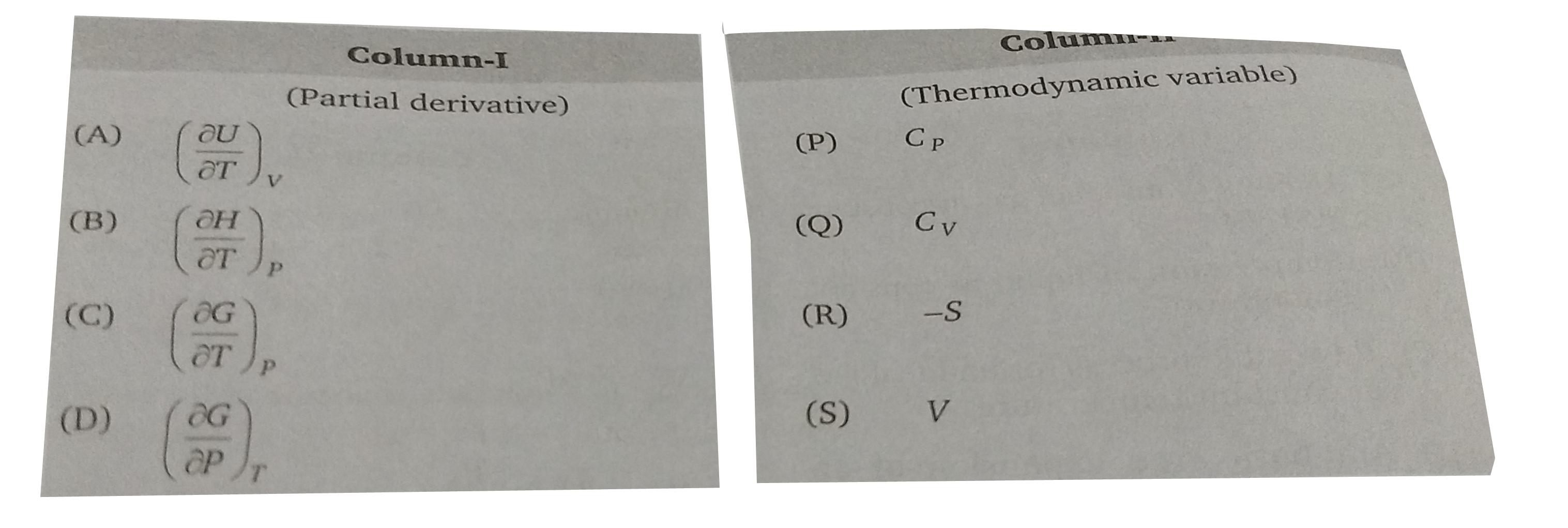The enthalpy of the reaction forming PbO according to the following equation is 438 kJ. What heat energy (kJ) is released in formation of 22.3 g PbO(s)?
(Atomic masses : Pb = 207, O = 16.0)
2Pb(s)+O2(g)→2PbO(s) Solution in Punjabi
21.9
28.7
14.6
34.2
The correct Answer is:A
Q=12×438×22.3223=21.9
Topper's Solved these Questions
- THERMODYNAMICSBook:NARENDRA AWASTHIChapter:THERMODYNAMICSExercise:Level 3 - One Or More Answers Are Correct
Explore 1 Video
- THERMODYNAMICSBook:NARENDRA AWASTHIChapter:THERMODYNAMICSExercise:Level 3 - Match The Column
Explore 2 Videos
- THERMODYNAMICSBook:NARENDRA AWASTHIChapter:THERMODYNAMICSExercise:Level 2 (Q.1 To Q.30)
Explore 1 Video
- STOICHIOMETRYBook:NARENDRA AWASTHIChapter:STOICHIOMETRYExercise:Level 3 - Subjective Problems
Explore 20 Videos
Similar Questions
Assume ideal gas behaviour for all the gases considered and neglect vibrational degrees of freedom. Separate equimolar sample. Separate equimolar samples of Ne, O2 , CO2 and SO2 were subjected to a two process as mentioned. Initially all are at same state of temperature and pressue.
Step I → All undergo reversible adiabatic expansion to attain same final volume, which is double the original volume thereby causing the decreases in their temperature.
Step → After step I all are given appropriate amount of heat isochorically to restore the original temperature.
Mark the correct option(s) :
View SolutionMatch the following columns

View SolutionWrite structure of 2,2-dimethylheptane.
View SolutionWhat volume of a liquid (in L) will contain 10 mole ? If molar mass of liquid is 280 and its density is 1.4 g/mL.
View SolutionThe enthalpy changes for two reactions are given by the equations: 2Cr(s) +(3)/(2)O_(2)(g) rarr Cr_(2)O_(3)(s), DeltaH^(Theta) =- 1130 kJ C(s) +(1)/(2)O_(2)(g)rarr CO_(2)(g), DeltaH^(Theta) =- 110 kJ What is the enthalpy change in kJ for the following reactions? 3C(s) +Cr_(2)O_(3)(s) rarr 2Cr(s) +3CO(g)
View SolutionThe standard Gibbs free energies for the reaction at 1773K are given below:
C(s)+O2(g)→CO2(g),ΔGΘ=−380kJmol−1
2C(s)+O2(g)⇔2CO(g),ΔGΘ=−500kJmol−1
Discuss the possibility of reducing AI2O3 and PbO with carbon at this temperature,
4AI+3O2(g)→2AI2O3(s),ΔGΘ=−22500kJmol−1
2Pb+O2(g)→2PbO(s),ΔGΘ=−120kJmol−1
View SolutionGiven that : 2CO_((g))+O_(2(g))rarr2CO_(2(g)),DeltaH^(@)=-P kJ C_((s))+O_(2(g))rarr CO_(2(g)), DeltaH^(@)=-Q kJ the enthalpy of formation of carbon monoxide is :
View SolutionThe enthalpy of the reaction forming PbO according to the following equation is 438 kJ. What heat energy (kJ) is releated in formation of 22.3 g PbO(s)? (Atomic masses : Pb = 207, O = 16.0) 2Pb(s) +O_(2)(g)rarr2PbO(s)
View Solution446 g of PbO , 46 g of NO_(2) and 16 g of O_(2) are allowed to react according to the equation :- PbO+2NO_(2)+(1)/(2)O_(2)toPb(NO_(3))_(2) The amount of Pb(NO_(3))_(2) that can be produced is (At . Wt. of Pb =207) :-
View SolutionThe enthalpy of formation of Fe2O3(s) is −824.2kJmol−1.Calculate the enthalpy change for the reaction :
4Fe(s)+3O2(g)→2Fe2O3(s)
View SolutionGiven ehthapy of formation of CO_2(g) and CaO(s) are -94.0 kJ and -152 kJ respectively and the enthalpy of formation CaCO_3(s) is
View SolutionConsider the following reactions. DeltaH^(@) values of the reactions hve been given as -x, -y and z kJ. Fe_(3)O_(4)(s) to 3Fe(s) + 2O_(2)(g), DeltaH^(@) = z kJ 2Fe(s) + O_(2)(g) to 2FeO(s), DeltaH^(@) =-x kJ 4Fe(s) + 3O_(2)(g) to 2Fe_(2)O_(3)(s), DeltaH^(@) =-y kJ Heat of reaction for the reaction, FeO(s) + Fe_(2)O_(3)(s) to Fe_(3)O_(4)(s) is :
View Solutionनिम्नलिखित रासायनिक समीकरण को संतुलित रूप में लिखिए-
Pb(NO3)2(g)ऊष्मा−−→PbO(s)+No2(g)+O2(g)
View SolutionThe enthalpy of formation of Fe2O3(s) is −824.2kJmol−1.Calculate the enthalpy change for the reaction :
4Fe(s)+3O2(g)→2Fe2O3(s)
View SolutionThe enthalpy of the reaction forming PbO according to the following equation is 438 kJ. What heat energy (kJ) is releated in formation of 22.3 g PbO(s)?
(Atomic masses : Pb = 207, O = 16.0)
2Pb(s)+O2(g)→2PbO(s)
View Solution